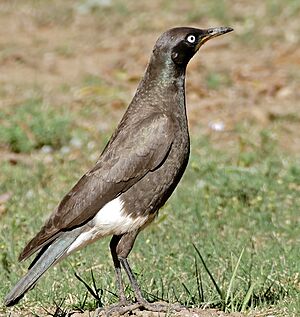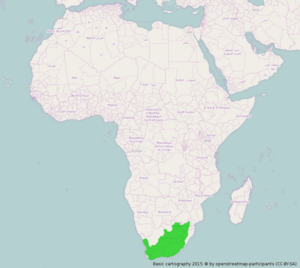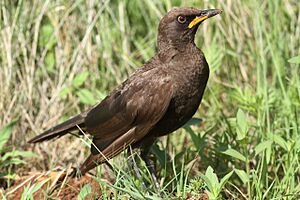Pied starling facts for kids
The pied starling or African pied starling (Lamprotornis bicolor) is a cool bird that you can only find in South Africa, Lesotho, and Eswatini. You can find them in most parts of these countries, but they don't live in the very dry northwest or the low-lying eastern areas of South Africa. They love open spaces like grasslands, thorny bushes, and farmlands. You'll often see them hanging out near farm animals!
Quick facts for kids Pied starling |
|
|---|---|
 |
|
| An adult bird at Mountain Zebra N. P. in the Eastern Cape, South Africa |
|
| Conservation status | |
| Scientific classification | |
 |
|
| native range | |
| Synonyms | |
|
Spreo bicolor |
Contents
What Does a Pied Starling Look Like?
Adult pied starlings are about 27–28 cm (11 inches) long. Most of their feathers are a dull, shiny black. But their lower belly and the feathers under their tail are white. They have bright white eyes and a yellow lower beak.
Both male and female starlings look very similar. Young starlings, called juveniles, have duller feathers. Their eyes are brown, and their lower beak is a dull yellow.
These birds make different sounds. Their most common call sounds like skeer kerrra kerrra. They also have a soft, musical song.
Pied Starling Behavior
Where Do Pied Starlings Build Their Nests?
Pied starlings usually build their nests in tunnels. They often dig these tunnels into river banks. But they can also use holes in buildings or even in piles of straw. Sometimes, they use natural holes in trees. There was even a record of a nest found inside an old, broken ship!
They line their nests with many different plant materials. They also use things that people throw away, like paper or pieces of rope.
Pied Starling Eggs and Chicks
A female pied starling usually lays four eggs. Sometimes, she might lay as few as two or as many as six eggs. The eggs are blue-green. They might be plain or have a few red spots.
Only the female bird sits on the eggs to keep them warm. This is called incubation. It takes about 14–16 days for the eggs to hatch. Once the chicks hatch, they stay in the nest for another 22–28 days before they are ready to fly.
Both parents help feed the baby birds. Sometimes, other adult starlings that don't have mates also help out. This is called "cooperative breeding." It means the whole group helps raise the young.
Pied starlings often have two sets of babies in one breeding season.
Pied Starling Flocks and Roosts
When they are not busy raising their young, pied starlings like to gather in large groups. These groups can have more than 1,000 birds! They often share their sleeping spots, called roosts, with other birds. These can include lesser kestrels or wattled starlings. They might eat with European starlings, but they usually don't sleep in the same places.
What Do Pied Starlings Eat?
Like many other starlings, the pied starling is an omnivore. This means they eat both plants and animals. They enjoy many different invertebrates (like insects), seeds, and berries. Their favorite foods are insects, especially ants and termites.
You might see them eating figs from gardens or even some food scraps that people leave behind. They often look for food near farm animals. They eat insects that the animals stir up from the ground. They also sometimes perch on cows or sheep to pick off tiny bugs that live on the animals.
Sometimes, pied starlings are seen as a problem when they eat soft fruits like grapes or figs. But people don't usually bother them much anymore.
Pied Starling Conservation Status
The pied starling lives in a very large area, which is about 790,000 km2 (310,000 sq mi). We don't know the exact number of these birds, but there are believed to be many of them. They are described as "common" in at least some parts of their home range.
Because they have such a large habitat and seem to have a big population, their numbers are not dropping quickly. For these reasons, the IUCN Red List considers the pied starling to be a species of "Least Concern." This means they are not currently at risk of disappearing.



